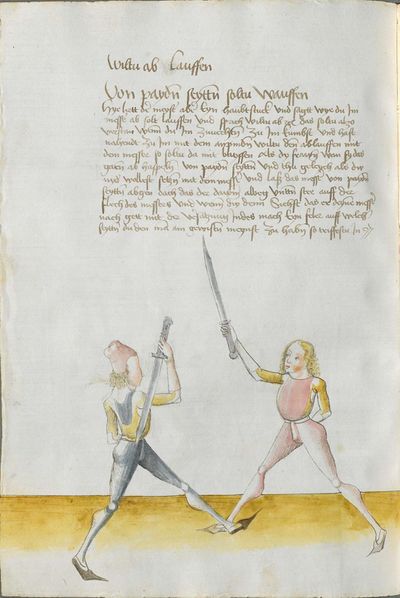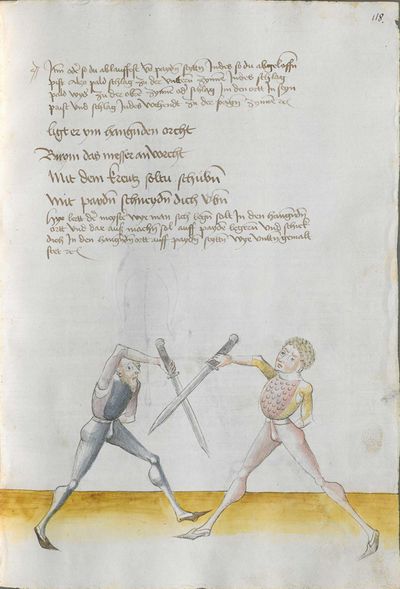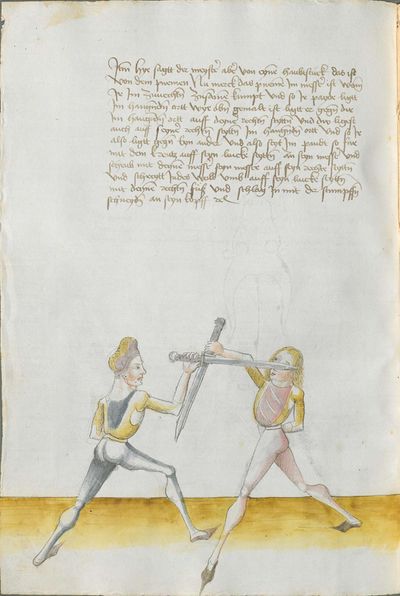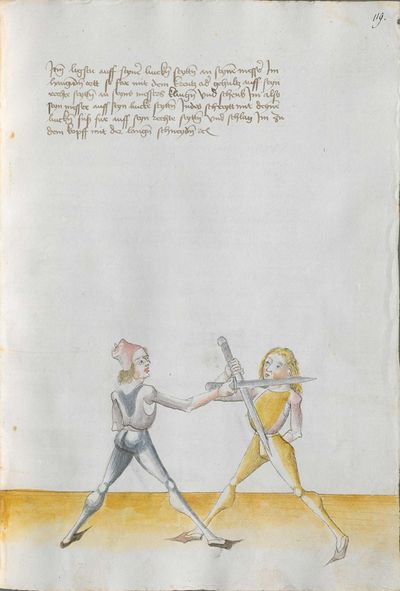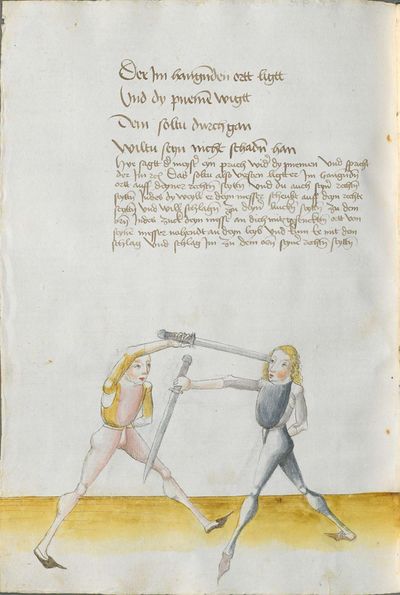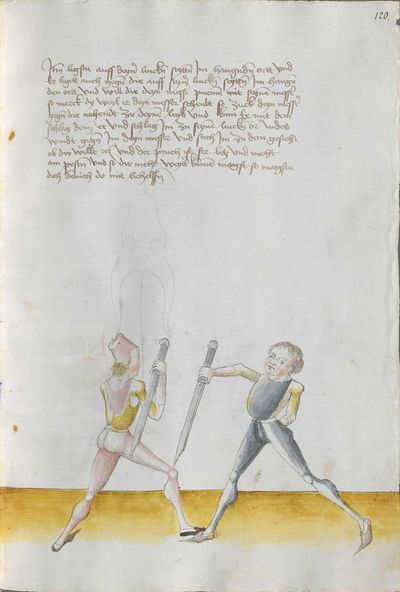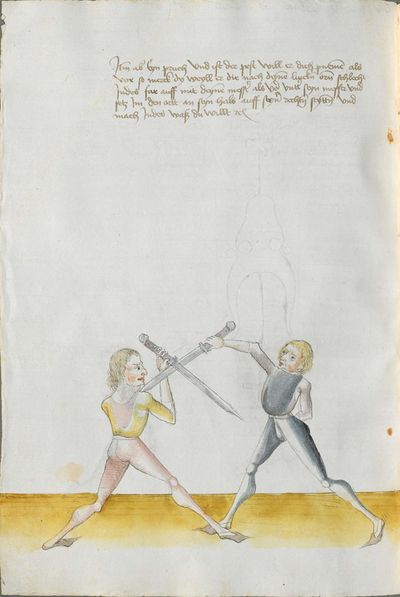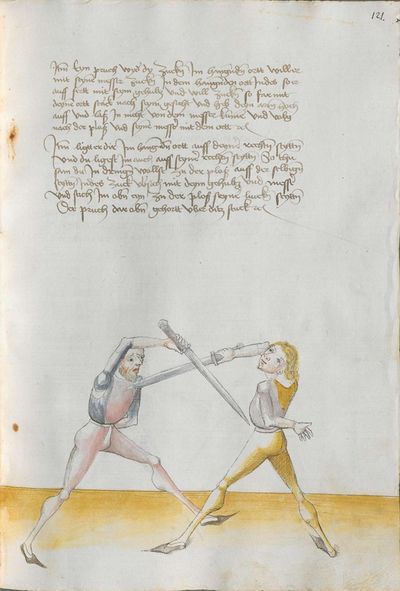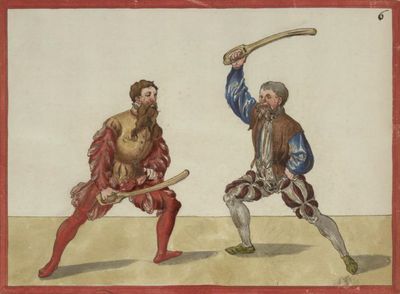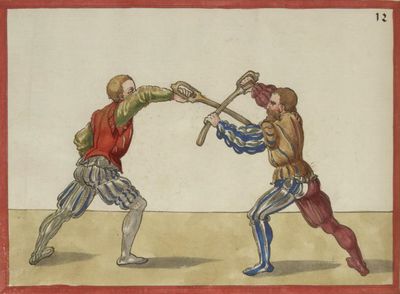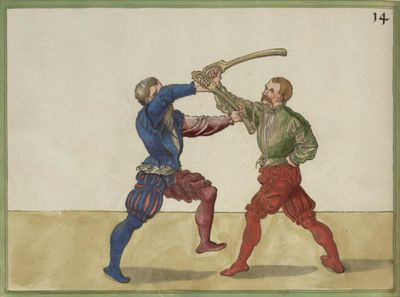|
|
You are not currently logged in. Are you accessing the unsecure (http) portal? Click here to switch to the secure portal. |
Difference between revisions of "Ablauffen"
James Reilly (talk | contribs) |
James Reilly (talk | contribs) |
||
| Line 1: | Line 1: | ||
| − | Ablauffen (Running-Off or Flowing-Off) means to withdraw from or evade the opponent’s weapon by rotating the blade downwards around the hilt. It is one of several techniques featured in the Handworks section of longsword techniques in [[Joachim Meÿer]]'s canon, and is also referenced in the longswoard and dussack sections of [[Paulus Hector Mair]]. The earliest appearance for Ablauffen is in the messer treatises of [[Johannes Lecküchner]]. | + | Ablauffen (Ablaufen, Running-Off or Flowing-Off) means to withdraw from or evade the opponent’s weapon by rotating the blade downwards around the hilt. It is one of several techniques featured in the Handworks section of longsword techniques in [[Joachim Meÿer]]'s canon, and is also referenced in the longswoard and dussack sections of [[Paulus Hector Mair]]. The earliest appearance for Ablauffen is in the messer treatises of [[Johannes Lecküchner]]. |
== Primary Sources == | == Primary Sources == | ||
Revision as of 20:13, 20 February 2016
Ablauffen (Ablaufen, Running-Off or Flowing-Off) means to withdraw from or evade the opponent’s weapon by rotating the blade downwards around the hilt. It is one of several techniques featured in the Handworks section of longsword techniques in Joachim Meÿer's canon, and is also referenced in the longswoard and dussack sections of Paulus Hector Mair. The earliest appearance for Ablauffen is in the messer treatises of Johannes Lecküchner.
Primary Sources
Images |
Featured Translation |
Heidelberg Version (1478) |
Munich Version I (1482) |
Salzburg Version (1491) |
Vienna Version (1512) |
Glasgow Version (1533) |
Mair's Dresden Version I (1542) |
Mair's Vienna Version I (1540s) [German] |
Mair's Vienna Version I (1540s) [Latin] |
Mair's Munich Version I (1550s) |
Munich Version II (1556) |
|---|---|---|---|---|---|---|---|---|---|---|---|
If you want to run off Here the master teaches a main element and states how you should run off in the Messer and speaks: if you want to run off, etc. You should understand it this way: if you come in the Zufechten to him, and you have close to him with the binding, and then you want to run off with the Messer, you should weave with it, as the women do when they unspool the yarn on both sides. And do as if you wanted to sit down with the Messer, and let the Messer go off from both sides, so that the thumb is always down on the flat of the Messer. And as you see that he follows your Messer with the displacement, do “simultaneously” a feint on the side on which you can have the man in the surest manner, in that way you hit him. |
Wiltu ablauffen, Hye lertt der meyster aber eyn hawbt stuck und sagt wye dw ym messer absolt lauffen und spricht wiltu ablauffen etc. Daß soltu alzo verstan wenn dw ym zw vechten zw ymb kumbst vnd hast nohent zw ym mit dem an pynden wiltu den ablauffen mit dem messer so soltu da mit bayffen alz dy frawen wenn si daß garen abwynten oder wayffen [59r] von payden seytten und thue gleich alz dw nyder seczen wollest und laß daß messer von payden seytten abgen doch daß der dawm albegen unten stee auff der flech deß messerß und wenn dw den stigst daß er deynem messer nach gett mit der versaczung yndeß mach eyn feler auff welcher seytten dw den man am gebisten mogst zw haben so triffest dw yn. |
[117v] Wiltu ab lauffen Hye lertt de[r] meyst[er] abe[r] Eyn haubtstuck vnd sagtt wye du Im messe[r] ab solt lauffen vnd sprich wiltu ab [etc] das soltu alzo verstan wenn[e] du Im zuuechten zu Im kumbst vnd hast nahendt zu Im mit dem anpind[e]n wiltu den[n] ablauffen mit dem messer so soltu da mit bayffen[1] als dy fraw[e]n wan sy das garn[n] ab haspel[e]n[2] von payd[e]n seytt[e]n vnd thu geleych als dw nyd[er] wollest setz[e]n mit dem mess[er] vnd laß das mess[er] von payd[e]n seytt[e]n abgen dach[3] das der dawm[en] albeg vntt[e]n stee auff der flech des messers vnd wenn[e] dw denn Sichst das er deyne[m] mess[er] nach gett mit der ve[r]satzung Indes mach Eyn feler auff welch seytt[e]n du den ma[n] am gewist[e]n meynst zu hab[e]n so triffestu In |
Wiltu ab lauffen Hie lert der meinster aber ey~ haupt stuck vnd sagett wie du im messer salt ab lauffen vnd spricht wiltu abe lauffen dz soltu also verstan wan du im zubechte~ zu im kümpst vnd hast nicht zu im mit dem anbinde~ wiltu dan ab lauffen mit dem messer so soltu do mit [80v] werffen als die fraulben wan sie dz garn ab haspeln von beide~ site~ vnd thün glich als wollest nider sitzen mit dem messer vnd loß dz messer von beide~ site~ ab gen doch dz der thüm alwegen vnte~ ste vff der flech des messers vnd wan du dan sihest dz er dinem messer noch get mit der versatzüng Indes mach eyn feller vff welcher site~ du den man an dem gewisesten meinest zu haben so trifstu in |
||||||||
| Then, or as you run off from both sides, “simultaneously” as you have run off from above, strike quickly to one of the lower peaks, and “simultaneously” strike quickly again to the upper peak. Or, strike the point at his chest and strike “simultaneously” skillfully to the previous peak. | oder so dw ablauffest von payden seytten yndeß so dw oben abgelauffen pist alzo pald schlag zw der unteren czynnen eyner yndeß schlag pald wyder zw den oberen czynnen | [118r] It[e]m od[er] so du ablauffest vo[n] payd[e]n seytt[e]n Indes so du abgeloff[e]n pist alzo pald schlag zu der untter[e]n zynne[n] Indes schlag pald wyd[er] zu der obre[n] zynne[n] od[er] schlag Im den ortt In seyn prust vnd schlag Indes nohendt zu der forig[e]n zynne[n] [etc] | oder so du ablauffest von beide~ site~ Indes so du oben ab gelauffe~ bist also bald schlach zu der vntern zynnen Indes schlag pald wider ze der obern zynnen oder schlag im den ortt in sin brust vnd schlag indes behend ze der vorigen zÿnnen ~ der in hangend~ ort lig~ | ||||||||
If he is in the hanging point Here the master teaches how one should assume the hanging point and what to do from it in both guards. And assume the hanging point on both sides as it is depicted below. |
Ligt er ym hangettem ortt, |
Ligt er ym hang[e]nden orcht Hye lertt de[r] meyste[r] wye man sich leg[e]n solt In den hang[e]nd[e]n ortt vnd dar auß mach[e]n sol auff payde[n] leger[e]n vnd schick dich In den hang[e]nd[e]n ortt auff payd[e]n seytt[e]n wye vntt[e]n gemalt stet [etc] |
Ligt er im hangenden ort |
Brüch
Der Im hanngenden ort ligt Item die weil Er sein Duseggen zum benemben scheubt. so zuckh dein Duseggen nachent zu deim leyb khum Ehe dann er vnnd schlag Im zum linncken ohr. Indes wind Im zum gesicht. |
|||||||
| Then, here the master speaks about a main element, that is about the taking over. Now notice that the taking over in the Messer is while you come together in the Zufechten and you both stand in the hanging point, as it is depicted above. If he stands against you in the hanging point on your right side and you stand as well on his right side in the hanging point, and you both stand against each other and are in binding, go with the crosspiece to his left side on his Messer and push his Messer to his right side with your Messer. “Simultaneously” step well around to his left side with your right foot and strike with the blunt edge at his head. | Hye sagt der meyster aber von eynem haubtstuck daß ist von den pnemen ym [59v] messer merck daß pnemen ym messer ist wenn Ir ym zw vechten zw sammen kumbtt und so Ir payde ligtt ym hangattem ortt* Item ligtt er gegen dir ym hangattem ortt ayff deyner rechten seytten und dw ligest auch auff seyner rechten seytten auch ym hangattem ortt und so ir alzo ligtt gegen eyn ander und alzo seit ym pandt so far mit dem kreucz oder gehultz auff seyn lincke seytten an seyn messer und scheub mit deynem messer auff seyn rechte seytten woll und schreit yndeß wol umb auff seyn lincke seytten mit deynem rechten fuß und schlag yn mit der stumpfen [60r] schneyden an seyn kopff
Sequitur textus. |
[118v] It[e]m hye sagtt der meyste[r] abe[r] von eyne[m] haubtstück das ist von dem pnemen Nu merck das pneme[n] Im mess[er] ist wenn[e] Ir Im zuuecht[e]n zusam[m]e[n] kumpt vnd so Ir payde ligtt Im hang[e]nd[e]n ortt wye ob[e]n gemalt ist ligtt er geg[e]n dir Im hang[e]nd[e]n ortt auff deyne[r] recht[e]n seytt[e]n vnd dw ligest auch auff seyne[r] recht[e]n seytt[e]n Im hang[e]nd[e]n ortt vnd so Ir also ligtt geg[e]n Eyn ander vnd also seyt Im pandt so far mit dem kreutz auff seyn lincke seytt[e]n an seyn mess[er] vnd scheub mit deyne[m] mess[er] seyn messer auff seyn rechte seytt[e]n vnd schreytt Indes woll vmb auff seyn lincke seytt[e]n mit deyne[m] recht[e]n füß vnd schlag In mit der stumpff[e]n schneyd[e]n an seyn kopff [etc] | [80v] Hie saget der meinster aber ein halbpt stuck dz ist von dem bnÿmen Nu merck dz benemen im messer dz ist wan ir im ze vechte~ ze samen kümptt vnd so ir beid ligt im hangende~ ort [81r] Itm~ ligt er gege~ dir ym hangende~ ortt vff diner rechte~ site~ vnd du ligst auch vff diner rechte~ site~ im hangende~ ort vnd so ir also ligent gegen eynander also stint ym band so far mit dem gehultz vff sin lincke siten an sin messer vnd schub mit dinem messer sin messer vff sin rechte site~ wol vnd schrit Indes wol vmb vff sin lincke site~ mit dinen rechte~ fus vnd schlag yn mit der stümpfen schnide~ an syn kopff
lig er ym hangende~ ort |
||||||||
| Then, if you stand on his left side on his Messer in the hanging point, go with the crosspiece or the hilt to his right side on the blade of his Messer, and push his Messer to his left side. “Simultaneously” step with your left foot forwards to his right side and strike at his head with the long edge. | * ligstu den auff seyner lincken seytten an seym messer so far mit dem kreucz oder gehulcz auff seyner rechten seytten an seynß messerß klyngen und scheub yn alzo seyn messer auff seyn lincke seytten yndeß schreit mit deynem lincken fuß auff seyn rechte seytten und schlag yn zw dem kopff mit der langen schneyden. | [119r] It[e]m ligstu auff seyne[r] linck[e]n seytt[e]n an seyne[m] messe[r] Im hang[e]nd[e]n ortt so far mit dem kreutz od[er] gehultz auff seyn rechte seytt[e]n in seyns messers kling[e]n vnd scheub Im also seyn messer auff seyn lincke seytt[e]n Indes schreytt mit deyne[m] linck[e]n füß fur auff seyn rechte seytt[e]n vnd schlag Im zu dem kopff mit der lang[e]n schneyd[e]n [etc] | [80v] ligstu dan vff [81r] siner lincke~ site~ an sinem messer so far mit dem crutz oder gehultz vff sin rechte site~ an sin messers klinge~ vnd schub im also sin messer vff sin lincke site~ Indes schrit mit dinem lincken fus vff sin rechte site~ vnd schlag im zu dem kopff mit der lange~ schnide~ | ||||||||
Who stands in the hanging point Here the master states an element against the taking over and a breaking and speaks: Who stands, etc. Then, another breaking against the taking over and is better than the first breaking and element, as the first element and the first breaking go quite badly, but this element and breaking goes firmly rightfully and do it this way: if he stands in the hanging point to your right side and you also [stand] on his right side, “simultaneously,” as he pushes your Messer to your right side and wants to strike to your left side to the ear, “simultaneously” twitch your Messer to yourself close to your body from his Messer with the lowered point. Then, come sooner with the stroke, and strike to his ear to his right side. |
Wer ym hangattem ortt ligtt, Hye sagt der meyster eyn stuck wyder dy pnemen und eyn pruch und spricht wer ym etc.* [60v] Item aber eyn ander pruch wyder dy pnemen und ist pesser wenn der erst pruch und stuck wann daß erst stuck und der erst pruch genen gar lecz zw aber dicz stuck und pruch gett fast recht zw und Thu ym alzo ligt er ym hangattem ortt auff deyner rechten seytten und dw auch auff seyner rechten seyten yndeß weill er deyn messer scheubt auff deyn rechten seytten und wil dich schlagen zw deyner lincken seytten zw dem oren yndeß czuck deyn messer an dich von seynem messer und kum ee mit dem schlag und schlag zw dem oren seyner rechten seytten |
[119v] Der Im hang[e]nden ortt ligtt Hye sagtt d[er] meyst[er] eyn pruch wid[er] dy pnemen vnd spricht der Im [etc] Das soltu also versten ligtt er Im hang[e]nd[e]n ortt auff deyner recht[e]n seytt[e]n vnd du auch seyn[er] recht[e]n seytt[e]n Indes dy weyll er deyn messer scheubt auff deyn rechte seytt[e]n vnd will schlag[e]n zu deyn[er] linck[e]n seytt[e]n zu dem or[e]n Indes zuck deyn messe[r] an dich mit gesenckt[e]m ortt von seyne[m] messer nohendt an deyn leyb vnd kum Ee mit dem schlag vnd schlag Im zu dem or[e]n seyne[r] recht[e]n seytt[e]n |
[80v] Der im hangenden ort ligt [81v] Hie saget der meinster ein bruch wider die benemen vnd spricht also [81r] Itm~ Aber eyn bruch wider die benemen vnd ist besser dan der b erst bruch wan dz erst stuck vnd der erst pruch gan gar letz zu Aber daß stuck vnd pruch gant vast recht ze im messer vnd thün Im also lit er im hangende~ ort vff diner rechte~ site~ vnd du auch uff siner rechte~ site~ Indes die will er din messer schubt vff din rechte~ site~ vnd die wil er wil schlagend ze diner lincke~ site~ ze den oren Indes zuck din messer an dich von sinem messer vnd küm e mit dem schlag vnd schlag im ze den oren ze siner rechte~ site~ |
||||||||
| You should do the breaking this way: if you stand on your left side in the hanging point and he also stands against you on his left side in the hanging point and wants to take over your Messer with his Messer, notice, while he pushes your Messer, twitch your Messer to yourself close to your body, and come sooner with the stroke than him, and strike at his left ear. “Simultaneously” wind your Messer against him and thrust at his face if you want, etc. And the breaking is very bad and not the best, and if you cannot come any further, you can still help yourself with it. | * Den pruch soltu alzo machen ligtt er auff deyner lincken seytten ym hangattem ortt und dw auch auff seyner lincken seytten ym hangattem ortt will er dir dan deyn messer pnemen mit seynem messer so merck weyll er deyn messer scheubtt so czuck deyn messer gegen dir und kum ee mit dem schlag den er und schlag yn zw seynem lincken oren yndeß wyndt gegen ym deyn messer und stich ym zw dem gesichtt | [120r] It[e]m ligstu auff deyn[er] linck[e]n seytt[e]n Im hangnd[e]n ortt vnd Er ligett auch geg[e]n dir auff seyne[r] linck[e]n seytt[e]n Im hang[e]n den ortt vnd will dir deyn mess[er] pneme[n] mit seyne[m] mess[er] so merck dy weyl er deyn messer scheubt so zuck deyn mess[er] geg[e]n dir nohendt zu deyne[m] leyb vnd kum Ee mit dem schlag denn[e] er vnd schlag Im zu seyne[n] linck[e]n or[en] Indes windt geg[e]n Im deyn messer vnd stich Im zu dem gesicht ob dw willt [etc] vnd der pruch ist ser letz vnd nicht am pest[e]n vnd so dw nicht weytt[er] kum[m]e[n] magst so magstu dich de[n]nich do mit behelff[e]n | [81v] ligt er vff diner lincke~ site~ im hangende~ ortt als vor vnd du ouch vff siner lincke~ site~ in dem selbigen ort wil er dir dan din messer benemen mit sinem messer so merck die will er sin messer schubt so zuck din messer gege~ dir nohent zu dim lib vnd küm e mit dem schlag im ze sinem lincke~ oren Indes wind gege~ Im din messer vnd stich im zu dem gesichtt ~ | ||||||||
Then, another breaking, and it is the best. If he wants to take over you as before, notice, as he strikes at your left ear, “simultaneously” go high with your Messer as before under his Messer and set the point on his neck to his right side and do “simultaneously” what you want. |
Item aber eÿn ander pruch und ist der pest wil er dich pnemen alz vor so merck dy weul er dir nach deynem lincken oren schlecht yndeß far auff mit deynem messer alz vor unter seyn messer und secz ym den ortt an seyn halz auff seyner rechten seytten und mach yndeß waß du wildt etc. Sequitur textus. |
[120v] It[e]m ab[er] Eyn pruch vnd ist der pest will er dich pneme[n] als vor so merck dy weyll er dir nach deyne[n] linck[e]n or[e]n schlecht Indes far auff mit deyne[m] mess[er] als vo[r] vntt[er] seyn messer vnd setz Im den ortt an seyn hals auff seyn[er] recht[e]n seytt[e]n vnd mach Indes waß du willt [etc] |
alliud
[82r] Itm~ Aber eyn ander bruch vnd ist der pest will er dich benemen als vor so merck die will er dir dan nach dinem lincke~ oren schlecht Indes far vff mit dinem messer als vor vnter sin messer vnd setz ym den ortt an sin hals vff siner rechte~ site~ vnd mach Indes wz du wiltt ~ wiltu In bnemen |
||||||||
| Then, a breaking against the twitching in the hanging point: if he wants to twitch with his Messer in the hanging point, “simultaneously”, as he goes high with his hilt and wants to twitch, go with your point firmly to his face and raise your arm high, and do not let him come from the Messer. Then, follow after the opening and his Messer with the point. | [121r] It[e]m Eyn pruch wyd[er] dy zuck[e]n Im hang[e]nd[e]n ortt willer mit seyne[m] messer zuck[e]n In dem hang[e]nden ortt Indes so er auff fertt mit seym gehultz vnd will zuck[e]n so far mit deyne[m] ortt sta[r]ck nach seym gesicht vnd heb deyn arm[e] hoch auff vnd laß In nicht von dem messer kum[m]e[n] vnd volg nach der ploß vnd seyne[m] messe[r] mit dem ortt [etc] | ||||||||||
| Then, if he stands in the hanging point on your right side and you also stand on his right side, do as if you wanted to rush to his opening to the same side. “Simultaneously” twitch upwards with your hilt and Messer and thrust at him from above to the opening of his left side. The breaking above belongs to this element. | It[e]m ligtt er dir Im hang[e]nd[e]n ortt auff deyne[r] recht[e]n seytt[e]n vnd du ligest Im auch auff seyne[r] recht[e]n seytt[e]n So thu sam[4] du Im dring[e]n wollst zu der ploß auff der selbig[e]n seytt[e]n Indes zuck vb[er]sich mit deym gehultz vnd mess[er] vnd stich Im ob[e]n eyn zu der ploß seyne[r] linck[e]n seytt[e]n Der pruch der ob[e]n gehortt vber ditz stuck [etc] |
|
Source Illustrations |
Incomplete Translation |
Dresden Ⅰ Version (1540s) |
Vienna Ⅰ Version [German] (1550s) |
Munich Ⅰ Version (1540s) Transcribed by Per MAgnus Haaland |
Vienna Ⅰ Version [Latin] (1550s) |
Draftbook Version (1540s) | |
|---|---|---|---|---|---|---|---|
|
[6] The Entrusthaw against the Oberhaw It happens that you stand in the Entrusthaw ("Anger Strike") with your left foot forward and hold your Duseggen with the hilt at your right knee such that the point is turned towards the opponent.[5] He then strikes to your upper opening, so follow outward with your right foot and go with your Duseggen up over your head so that the long edge is turned upward and his strike is displaced. Then immediately strike quickly with the Zwirch to his right ear. If he strikes like this with a Zwirch to your right ear and you stand with your right foot forward, displace him with your long edge and follow outward with the left foot. Then quickly Ablauffen ("flow off") and strike his right arm. If he displaces this, follow after him double with a thrust to his face or chest. If he then follows after you like this, step to the rear with your right leg and strike him at the same time double to his head. If he strikes double like this towards you, step with your right foot in front of his left and wind with your short edge on his long edge at his left side. Then immediately cut to his face or neck. |
[118v] Der entristhaw Gogen dem Oberhaw Item schickh dich Allso mit dem Entristhaw. stee mit deinnem lincken fuosz vor vnnd hallt dein duseggen auf deinnem rechten knie mit dem hefft. das der Ort gegen dem Mann gewenndt sey hawt Er dann deinner obern ploss zu. so volg mit deinnem rechten fuosz hinnach vnnd gee mit dem duseggen. auf vber dem haupt. das die lanng schneid oben gewenndt sey. so ist Im der haw versetzt. Indes haw dich behendigelich Inn die zwirch nach seinnem rechten Ohr zwircht er dir dann also zu deinnem rechten Ohr. vnd du mit deinnem rechten fuosz vorsteest. so versetzt Im das mit deinner Lanngen schneid vnd volg mit dem lincken fuosz hinnach. lasz Inn dem behend ablauffen. vnd haw Im nach seinem rechten Arm. versetzt Er dir das furbas. so Raisz Im zwifach nach mit ainnem stich nach seinnem gesicht. oder der prust. begert Er dir dann also nach zuraisen. so trit mit deinnem rechten schennckel zuruckh vnd haw Im Indes zwifach nach seinnem haupt hawt er dir dann zwifach nach so tritt mit deinnem rechten fuosz fur seinnen. Lincken vnnd wind mit deiner kurtzen schneid auf sein lannge. auf sein lincke seitten. Indes schneid Im nach seinem gesicht oder dem hals |
[099v] Der entrusthaw gogen dem oberhaw Item schich dich also mit dem Entristhaw steennt deinnem lincken fuoss vor unnd halte dein duseggen auf deinnem recthen knie mit dein hefft das der Ort gegen dem ajann gewenndt sey, hawt Er dann deinner obern vloss zu, so volg mit deinnem rechten fuoss hinnach unnd gee mit dem duseggen auf ober dien haupt das die lanng schneid oben gewenndt sey, so ist Im der haw versezt, Indes haw dich behendiglich Inn die zwirch nach seinnem rechten Ohr, zwirch er dir dann also zu deinnem rechten Ohr und du mit deinnem rechten fuoss vor stesst, so versez Im das mit deinner lanngen schneid und volg mit dem lincken fuoss hinnach, lass Inn dem behend ablauffen und haw Im nach seinem rechten Arm, versezt Her dir das furbas, so raiss Im zwifach nach mit ainnem stich nach seinnem gesicht oder der prust begert, Er dir dann also nach zuraisen , so trit mit deinnem rechten schennckel zuruch und haw Im Indes zwifach nach seinnem haupt, Hawt er dir dann zwifach nach, so trit mit deinnem rechten fuoss fur seinnen lincken unnd wind mit deinner kurzen schneid auf sein lannge auf sein lincke seitten, Indes schneid Im nach seinnem gesicht oder dem hals. |
[102v] Ictus severus contra ictum supernum. Eum habitum ita exercebis: sinistrum pedem praeponito, et acinacem supra genu dextrum tuum contineto ex capulo ita ut mucro contra adversarium sit porrectus, et si versus nuditatem supernam adversarius feriat, dextro pede consequitor, et elevato acinace supra tuum caput, conversa acie longa superne, frustra hostis feriet, eadem ratione eius ictus eludetur. Celeriter autem transversarius ictum usurpando adversarii aurem dextram pulsabis. Sin vero habitu consimili is usus fuerit contra te, te dextrum praefigente pedem, ictum eius acie longa praemissa avertes. Sinistro insequitor, et celeriter ictu iterato, eius brachium dextrum adpetito. Sed si is rursus ictum averterit, dupliciter instando consequeris, mucronem in faciem eius vel pectus infigendo. Quum vero modo non dissimili tibi obviarit, pedem dextrum referto, et caput eius ictu gemino appetes. Sin autem is eadem ictus ratione contra te utatur, tum pedem dextrum adversarii sinsitro praepones, atque aciem acinacis tui brevem in eius longam inflectendo adpones versus adversarii latus sinsitrum, et inde incidendo in eius faciem vel collum prorumpes. |
[099v] |
|||
|
[12] An Einschiessen against the Kron It happens like this with the Einschiessen ("shooting in"). Set your right foot forward and shoot the point to his face or chest with an extended arm. If he shoots the point to your face like this and you stand against him in the Kron ("Crown") with your left foot set forward, take this away with the Kron. Then immediately turn yourself out of the Kron into a position with your Duseggen over your head. Follow outward with your right leg and strike from below to his right arm. If he displaces this, allow it to Ablauffen ("run off") and strike from above to his right side. If he strikes you like this from below and above, drop a Krump on him over his right arm and step in with your left leg, set your left hand on his right elbow and shove him away from you so that you can strike him to the head from above. If he has then set upon you and shoved you away from himself like this, pull your right foot to the rear so that you go out of his grip and come to similar work with him. Immediately thrust to his face with your point. If he sets this aside, then step in again with your right leg and strike from below to his left side. Then immediately strike with an Oberhaw as you move away from him. |
[121v] Einn einschiessen gogen der Kron Item schickh dich Also mit dem Einschiessen. setzt deinnen Rechten fuosz fur. vnnd scheusz Im dem Ort nach seinnem gesicht oder der prust mit gestracktern arm scheust Er dir also den ort nach deinnem gesicht. vnnd du gögen Im steest Inn der Kron. deinen Linncken fuosz furgesetzt. so nim Im das hinweckh mit der Kron Indes wind dich ausz der kron. Inn die versatzung dein duseggen vber dein haupt volg mit deinnem rechten schennckel hinnach. vnd haw Im von vnnden nach seinnem rechten arm. versetzt er dir das. so lasz ablauffen. vnd haw Im oben nach seiner rechten seitten. hawt Er dir also vnnden vnd oben zu. so fall Im krumb ein vber seinen rechten arm. vnnd trit mit deinnem linncken schenckel hinnein setz dein lincke hand an seinen rechten Elnpogen. scheub In damit vonn dir. so zeuch deinnen rechten fuosz zuruckh. so gastu Im ausz dem ansetzen. vnnd kompst mit Im zu gleicher arbait Indes stich Im mit deinem ort zu seinem gesicht. setzt Er dir das ab. so trit mit deinnem rechten schennckel wider hinein. vnd haw Im von vnden zu seiner lincken seiten. Indes haw dich mit ainnem ober haw von Im. |
[102v] Einn einschiessen gogen der Kron Item: schich dich Also mit dem Einschiessen sezt deinnen rechten fuoss fur unnd scheuz Im denn Ort nach seinnem gesicht oder der prust mit gestracktem arm, scheust Er dir also den ort nach deinnem gesicht unnd du gogen Im steest Inn der Kron deinen linncken fuoss fur gesezt, so nimb Im das hinneck mit der Kron, Indes wind dich auss der Kron Inn die versazung dein duseggen uber dein haupt, volg mit deinnem rechten schennckel hinnach und haw Im von unnden nach seinnem rechten arm, versezt er dir das, so lass ablauffen und haw Im oben nach seinner rechten seitten, hawt Er dir also unnden und oben zu, so fall Im Krump ein uber seinen rechten arm und trit mit deinnem linncken schenckel hinnein, sez dein lincke hand an seinnen rechten Ehrpogen, scheub In damit vonn du, so magstu In oben zu dem kopff hawen, hat er dir dann angesezt und scheubt dich also von Im, so zeuch deinner rechten fuoss zuruck, so gastu Im auss dem ansezen unnd kompst mit Im zu gleicher arbait, Indes such Im mit deinnen ort zu seinem gesicht, sezt Er dir das ab, so trit mit deinnem rechten schennckel wider hinein und haw Im von unden zu seiner lincken seiten, Indes haw dich mit ainnem oberhaw von Im |
[105v] Contra habitum coronae impulsus sev acinacis iniectio. Eum in habitum hac ratione te adaptabis: dextrum pedem si praefixeris, mucronem acinacis vultui adversarii, vel pectori eius impellendo adplicabis brachiis porrectis. Verum si is mucronem in tuam faciem adegerit, te in habitu Coronae consistente, atque sinistrum praefixeris, coronae habitu eum avertes. Interim vero ex eo habitu deflectes in tui defensionem, elevato acinace supra caput tuum, dextro pede insecutus, ex loco infero sursum eius brachium dextrum tundendo appetes. Et si hostis id exceperit, tum deflectes ictum versusque eius latus dextrum superne feries. Porro si is superne et inferne te laedere cupiverit, curve ei concides supra brachium adversarii dextrum. Introque pede dextro procedes, manu sinistra eius cubito dextro applicata si propuleris abs te, facile caput eius contundere licebit. Sin vero ratione consimili adversarius utetur atque te removerit, dextrum referre memineris, et hoc modo praenominatum habitum vitabis, et aequales conatus cum adversario exercebis. Interim vero in eius faciem mucronem impellito. Sed si eum averterit, rursus intro dextro concedas pede, atque si ex loco infero sursum feriundo, eius latus sinistrum adpetes, ictum supernum usurpando ab adversario te separato. |
[102v] |
|||
|
[14] A Cut from Below with a Zwirchhaw It happens at the closing that you stand in the cut from below with your left foot forward and make as if you will strike him from above. Then immediately grip with your left hand forward on the Duseggen and turn into the cut from below to his right arm. If you stand opposite him with your left foot forward in the Zwirchhaw and he cuts like this towards your right arm, turn yourself with your Duseggen above his and with that snatch towards yourself. Thus you have countered his cut and may cut him. If he intends to set this aside, step to the rear with your left leg and thrust to his face. If he then thrusts like this to your face, displace this with the Bogen, step outward with your right foot and strike to his left side. If he displaces this, step to the rear with your right foot and strike with a Zwirch to his right arm. If he strikes like this to your right side, follow after him with your left foot and strike from below to his right elbow. If he displaces this, allow it to immediately Ablauffen ("flow off") and strike from above to his right arm. |
[122v] Ein vnnderer schnit mit ainnem zwerchhaw Item schickh dich allso Mit dem zufechten. Inn den vnndern schnit. stee mit deinnem lincken fuosz vor. vnnd thuo sam wollest du Im oben ein hawen. Indes greiff mit deinner lincken hannd vornen. Inn den duseggen. vnd wind dich In den vnndern schnit nach seinnem rechten arm. stastu dann gegen Im mit deinnem lincken fuosz vor. Inn dem zwirchhaw vnnd Er dir also nach deinnem rechten Arm. schneidt. so wind dich mit deinnem duseggen vber den seinnen. vnnd reyss damit an dich so hastu Im den schnit prochen. vnnd magst In schneiden. begert er dir das zuversetzen. so trit mit deinnem linncken schenckel zuruckh vnnd stich Im nach seinem gesicht sticht sticht er dir dann also nach deinnem gesicht so verscheub Im das mit dem pogen. trit mit deinnem rechten fuosz hinnach vnd haw Im nach seinner linncken seitten. versetzt er dir das. so trit mit deinnem rechten fuosz zuruckh vnd haw Im die zwirch nach seinnem rechten Arm. hawt Er dir also zu deinner rechten seitten. so rais Im mit deinnem lincken fuosz nach. vnd haw Im von vnnden. nach seinnem Rechten Elenpogen. versetzt Er dir das. so lasz Indes behennd ablauffen. vnd haw Im oben nach seinem rechten arm. |
[103v] Ein unnderer schnit mit ainnem Zwerchhaw Item: schich dich allso mit dem zufechten Inn den unndern schnit stee mit deinnem lincken fuoss vor unnd thusam woltest du Im oben einhawen, Indes greiff mit deinner lincken hannd vornen Inn den duseggen und wind dich In den unndern schnit nach seinnem rechten arm, stastu dann gegen Im mit deinnem lincken fuoss vor Inn dem zwirchhaw unnd Er dir also nach deinnem rechten Arm schneidt, so wind dich mit deinnem duseggen uber den seinnen unnd reuss damit an dich so hastu Im den schnit prochen unnd magst In schneiden, begert er dir das zu versezen, so trit mit deinnem linncken schenckel zuruck unnd stich Im nach seinem gesicht, Sticht er dir dann also nach deinnem gesicht, so verscheub Im das mit dem pogen, trit mit deinnem rechten fuoss hinnach unnd haw Im nach seinner lincken seitten, versezt er dir das, so trit mit deinnem rechten fuoss zuruck und haw Im die zwirch nach seinnem rechten Arm, hawt er dir also zu deinner rechten seitten, so rais Im mit deinnem lincken fuoss nach und haw Im von unnden nach seinnem rechten Elenpogen, versezt er dir das, so lass Indes behennd ablauffen und haw Im oben nach seinnem rechten arm. |
[106v] Incisio infera cum ictu transversario. Hoc modo te ad incisionem praedictam compones, sinistrum pede praefiges, et quasi superne adversarium ferire cupias assimilabis, interea partem acinacis anteriorem apprehende manu sinistra, atque inflectendo te in incisionem inferam accommodabis appetendo brachium adversarii dextrum. Ceterum si contra eum constiteris, sinistrum pede praeponens arrepto transversario, et incidere brachium tuum dextrum conetur, tum acinacem inflectendo supra acinacem hostis reges, eo habitu si attraxeris versum te vellendo, adversarii incisionem effugies. Simul etiam eum stringere poteris. Sin autem eam volet avertere, pedem sinistrum retrorsum reduces, atque mucronem versus faciem eius dirigito. Porro, si idem scilicet habitum praenominatum usurpet, arcus habitu qui paulo superius descriptus est, eum excipies, dextro si fueris confestim insequutus versus latus adversarii sinistrum ferias: et si ictum tuum eluserit, pedem dextrum referes, atque feriundo transversarium, brachium eius dextrum contundes. Verum si is eo modo te aggreditur, tum instando pede sinistro sursum regendo ictum ab inferne sursum directum versus adversarii cubitum dextrum feries. Excipiente vero adversario, ictu celeriter remisso, superne eius brachium dextrum sauciato. |
[103v] |
Images |
1560 Edtition |
1570 Edition | |
|---|---|---|---|
| Flowing Off
On whichever hand you bind on your opponent’s sword, so move while retrieving your hand, and let yourself flow off below you with the half edge, and twitch under to bring your riccasso high overhead to strike, and drive such to both sides. |
Ablauffen.
ISt / von welcher Handt du dem Mann an sein Schwerdt bindest / so verkehr in dem es riert dein Hand / und laß mit halber schneid undersich ablauffen / und zuck under des dein Hefft ubersich in die höh zum streich / und solches treib zu beiden seiten. |
Video Interpretations
{{#evp:youtube|Y9S9aB_2jsI| Luca C. (2013)|left}}

